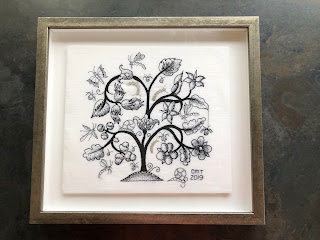 |
| Jacobean sample |
 |
| Montenegrin sample |
I see the Montenegrin sample as a piece that fulfils middle class values. In order for this to be stitched in 1653 (date of the original sampler by Elizabeth Billingsley) it required wealth (for the linen, dyed silks, hand made needles, and embroidery frame -threads were finished on the top, as the frame could not be flipped). Thus she came from an affluent family. Her education taught her decorative, and highly complex stitches - therefore she was a child whose time was spent on non-utilitarian sewing. Her leisured occupation led to her being highly skilled - Montenegrin is incredibly complex, and she must have had a lot of practice to stitch it so well, in so many directions.
For all that I admire Elizabeth Billingsley's skills, I reflect that her use of Montenegrin stitch is cleverness, for cleverness' sake. Its purpose is to densely cover the fabric. Which it does. Incredibly complexly. I have mastered it, through many hours work, yet I cannot identify when I would use it again. It is very useful for patterning as demonstrated above, but I cannot see further use for it.
The Jacobean sampler is not my taste because although I enjoyed the process of stitching, and learned a new, useful stitch, it creates a picture. The Jacobean Royalist symbolism is not readable to a modern audience. The tree is an oak (Boscobel oak), with acorns (royal lineage), butterfly and caterpillar (Charles I and Charles II), borage flowers (courage), spider (concealed hiding place of Charles I), hazelnuts (?) bedbugs, fleas, snail etc. I loved working with the two weights of silk thread, and learned to do Elizabethan twisted chain stitch for the trunk. This was not part of the kit design. Elizabethan twisted chain stitch is very effective to get sinuous curves.
But the process of working with the Jacobean 'picture' made me think about iconography. My choice of iconography is about working class objects, like toilet brushes, cleaning bottles, and car seats. It is not about flowers , which were traditionally painted by genteel ladies. Rozsika Parker notes the iconography in samplers often selected the same biblical stories about women. So I need to reflect on inconography and class.
No comments:
Post a Comment